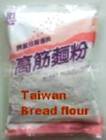 |
||||
|
Understanding Flour Every baking occasion demands flour perfectly suited
for its intended purpose – a trade secret known by professionals. |
||||
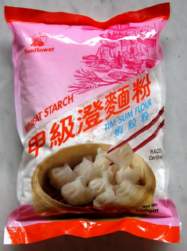 |
Wheat starch or tang meen fun, or Tang flour
is all the gluten has
been removed. When mixed with water it produces a pastry dough. It
is mainly used as a wrapping for dumplings such as ‘har kau’or ‘choy
pau.’ It cannot be substituted with potato or other starches. It has
different properties and will give food a different texture. It
gives a very transparent or translucent texture. It is
essential that the proportion of wheat starch to water be well
balanced when making the pastry for har kau. |
|||
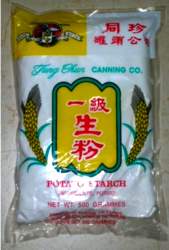 |
Potato flour or potato starch is flour ground from
dried potatoes; it is carbohydrate based thickener with little
protein, useful for people who have to avoid gluten flours. It is
used primarily for making commercial potato bread in combination
with plain or strong flour or as a thickener for soups, gravies and
Chinese stir fly dishes. The high starch content in potato flour
encourages rapid fermentation and quick rise in yeast doughs. As
such as a starch for thickening it has greater power than cereal
starch and smaller quantities are required. It also gives a more
translucent finish to soups and sauces as compared with corn flour
or tapioca flour |
|||
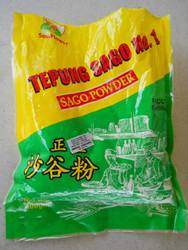 |
Sago is dried starch granules derived from the pitch
of sago tree. Sago flour is very rich in starch and has the same
thickening ability as tapioca flour. In fact sago and tapioca flour
may be used interchangeably for making kuih, bread and cakes. |
|||
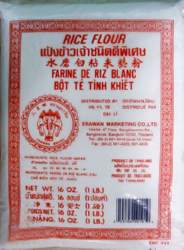 |
Rice flour
(includes white rice flour and nuttier
brown rice flour) Substitutes: cake flour (especially if the rice
flour is intended to soften the texture of a baked good) OR barley
flour (also delivers a softer texture to baked goods) OR pastry
flour (also delivers a softer texture to baked goods) OR (for those
allergic to wheat) spelt flour (makes baked goods heavier) OR potato
flour OR millet flour |
|||
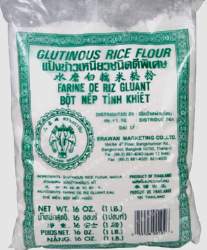 |
Glutinous rice flour or sticky rice, is a common component in Asian
cuisine. It is also known as sweet flour or waxy rice flour. When
cooked, glutinous rice becomes moist and firm but also develops a
notable stickiness. It is frequently used in Asian recipes to
thicken sauces or bind ingredients. This flour is known for its
ability to absorb any liquid it comes into contact with, resulting
in the creation of a slightly rubbery, clay-like ball of dough. The
flour is created by crushing whole grains of rice and processing
them until they have reached the consistency of a fine powder that
is ultra white in color and slightly sweet. This naturally sweet
flour is then used to make buns, dumplings and assorted pastries. |
|||
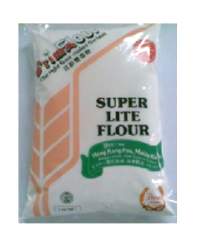 |
SUPERLITE FLOUR
Just another name for Hong Kong flour made in Singapore and Malaysia. Superlite is a super soft flour. The Flour have been beached to give a very white texture. It is best used for making Hong Kong type steamed buns (bao), Japanese castella cake, Malay sponge cake (kueh bahulu) and others where a specially soft and light texture is required. This flour is also referred to as "Hong Kong Flour" by some users. |
|||
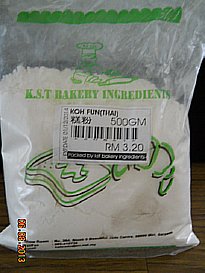 |
Koh Fun is commercialised cooked glutinous rice flour.
It is mainly used in snow skin Mooncakes and as fillings like lao poh piah and many others. Here are two methods to make your own. 1.Place the quantity glutinous flour you need into the oven and bake for 25-30 mins at 160'c until browned and stir every 10 mins; or simmer it over a non-stick frying pan under low heat untill it became loose and dry 2.Steam plain glutinous rice flour for about 30 mins. Remove and put in a microwavable glass bowl lined with greaseproof paper. Microwave on high 1 minute at a time (or 30 sec intervals if your microwave is quite powerful) until the flour is slightly brown (time depends on the amount of flour) |
|||
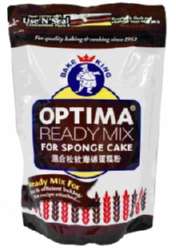 |
Optima flour is a premixed
cake mix flour made in Singapore
for making sponge cake. It contains sugar and baking powder and other conditioner to give nice texture of cake. To substitute Optima flour, just substitute any sponge cake mix of any brand available. |
|||
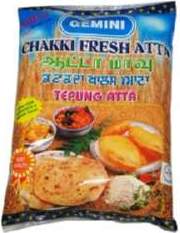 |
ATTA FLOUR Atta flour is a whole wheat-flour made from hard wheat grown across the Indian subcontinent. It may be used to make bread with, but add 200 g of finely ground Oats to 1 Kg of Atta Flour. Flatbread made from Atta, such as chapati, roti, naan and puri, are an integral part of Indian cuisine. Atta is the main ingredient of most varieties of Indian, Bangladeshi and Pakistani bread. |
|||
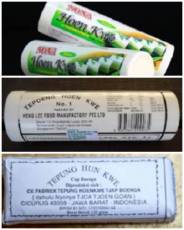 |
Hoen Kwe flour or Hun kwe flour Hoen Kwe flour is green bean/pea flour that has been flavoured and are made in Indonesia, Singapore and Malaysia. Hoen kwe flour commonly comes in white packaging which is uncoloured. There are some green packaging which has green coloured , while the red packaging has pink coloured and yellow packaging has yellow coloured. |
|||
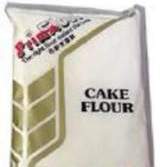
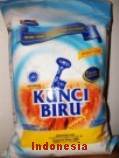 Cake flour is a finely milled
flour made from soft wheat. It has very low gluten content, making
it suitable for soft-textured cakes and cookies. The higher gluten
content of other flours would make the cakes tough. Related to cake
flour are masa harina (from maize), maida flour (from wheat or
tapioca), and pure starches. Cake Flour is a superb quality,
soft-as-silk flour. It has excellent tolerance to a high amount of
butter and sugar, resulting in cakes of good volume. This flour is
best used for baking sponge cakes and very rich cakes like pound
cakes.
Cake flour
does not have Sugar or baking powder added . Cake flour is a finely milled
flour made from soft wheat. It has very low gluten content, making
it suitable for soft-textured cakes and cookies. The higher gluten
content of other flours would make the cakes tough. Related to cake
flour are masa harina (from maize), maida flour (from wheat or
tapioca), and pure starches. Cake Flour is a superb quality,
soft-as-silk flour. It has excellent tolerance to a high amount of
butter and sugar, resulting in cakes of good volume. This flour is
best used for baking sponge cakes and very rich cakes like pound
cakes.
Cake flour
does not have Sugar or baking powder added .To Substitute cake flour - For every one level cup of all-purpose flour, remove two tablespoons, and then add two tablespoons of corn starch back in. |
||||
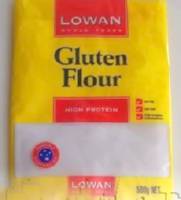 |
Gluten flour is a natural high protein, free-flowing powder
extracted from premium quality wheat flour. It contains over 70%
protein. It can be added to low gluten flour to enchance the bread
volume. It increases the baked bread elasticity without toughening
the eating quality. Gluten flour or powder may be obtained or bought from "Heath Food Shop". You can buy "loose" depending on how many gm you want instead of in packet. To convert plain flour to bread flour, add about 1 tablespoon of gluten flour/powder with 2 cups of flour. Sieve well and you will have bread flour |
|||
|
Difference between Bread Flour and all Purpose flour Wheat flours contain a protein called gluten which, in
the presence of water, forms an elastic network throughout the
dough. This is the stuff that gives bread dough their rubbery
consistency. The whole point of kneading bread dough, in fact, is to
organize the strands of gluten running through the dough into a
strong, resilient, interconnected web. It is this web of protein
that will entrap the bubbles of CO2 given off by the yeast as it
ferments, enabling the dough to rise. Without the gluten, the CO2
would just bubble up to the surface and be lost. Gluten free flours - As
explained above gluten is what makes wheat-based bread dough so
sticky and elastic. This helps the dough hold in the air bubbles
created by the yeast so that it will rise and eventually bake into a
fluffy, porous loaf. If you're gluten-intolerant, though, you'll
need to use gluten-free flour, along with an arsenal of ingredients
to make it behave like it has gluten.
|
||||






